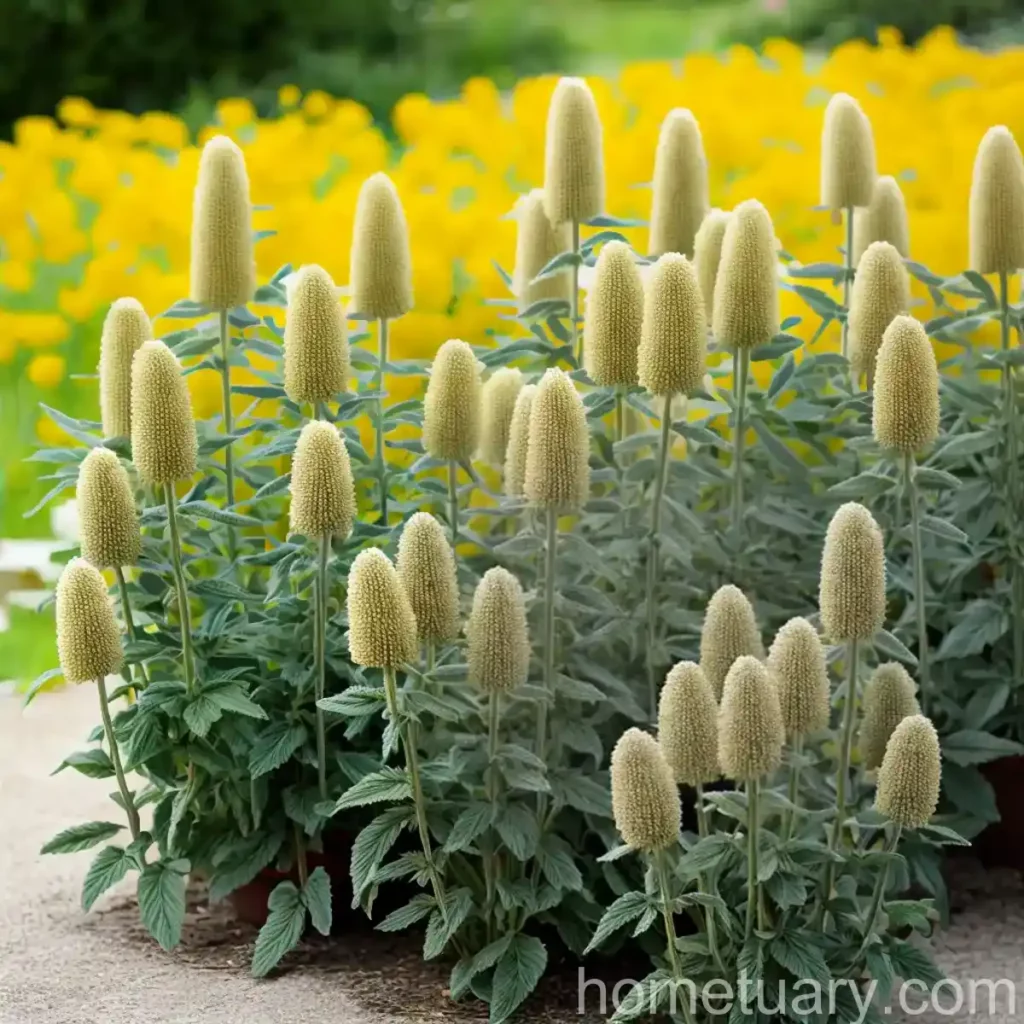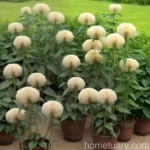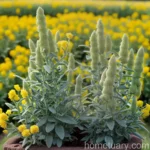Turkish Sage (Phlomis russeliana): A Complete Guide
Turkish sage, scientifically known as Phlomis russeliana, is a beautiful perennial plant that is prized for its ornamental and medicinal properties. In this comprehensive guide, we will explore the various aspects of Turkish sage, including its description, cultivation practices, medicinal uses, landscape uses, and much more. Whether you are an avid gardener, a landscape designer, or simply someone who appreciates the beauty of plants, this guide will equip you with the knowledge to cultivate and appreciate this remarkable species.
What is Turkish Sage (Phlomis russeliana)?
Turkish sage, or Phlomis russeliana, is a species of flowering plant in the mint family (Lamiaceae). It is native to the Eastern Mediterranean and is well-known for its striking whorls of hooded, yellow flowers and attractive, woolly leaves. This herbaceous perennial is valued for its ability to thrive in a wide range of environmental conditions and its versatility in landscape design.
Key Takeaways – Turkish Sage (Phlomis russeliana)
Before delving into the specifics of Turkish sage, let’s take a look at the key takeaways about this fascinating plant:
- Botanical Name: Phlomis russeliana
- Family: Lamiaceae
- Common Name: Turkish Sage
- Native Habitat: Eastern Mediterranean
- Growing Season: Perennial
- Flowering Period: Late spring to early summer
- Sunlight Requirement: Full sun to partial shade
- Watering Needs: Drought-tolerant once established
- Soil Type: Well-drained, moderately fertile soil
- Height: 2-3 feet
- Uses: Ornamental, medicinal, culinary
Now that we have the basic overview, let’s delve into the specifics of cultivating and appreciating Turkish sage.
Plant Description
Overview
Turkish sage is characterized by its distinctive appearance, featuring upright stems with whorls of woolly, heart-shaped leaves and clusters of tubular, yellow flowers. The plant forms a clump and can grow to a height of 2 to 3 feet, with a spread of 2 to 4 feet. Its woody stems add winter interest to the landscape.
Flowers
The flowers of Turkish sage are particularly noteworthy, as they are arranged in dense, whorled clusters atop tall stems. The tubular flowers have a characteristic hooded appearance, adding unique charm to the plant. The flowering period typically occurs from late spring to early summer, offering a vibrant display of color in the garden.
Foliage
The foliage of Turkish sage consists of attractive, gray-green, woolly leaves that provide texture and visual interest even when the plant is not in bloom. The leaves are oval or heart-shaped and are arranged in whorls along the stems. The woolly texture contributes to the plant’s ability to withstand dry conditions.
Aromatic Properties
One of Turkish sage’s appealing features is its aromatic foliage. When brushed or crushed, the leaves release a pleasant, herbal fragrance, adding to the sensory experience of growing and interacting with this plant.
Characteristics
Perennial Nature
As a perennial plant, Turkish sage regrows year after year, making it a valuable addition to gardens and landscapes that desire long-term beauty and sustainability. Its ability to endure and thrive through multiple growing seasons makes it a popular choice for perennial garden beds.
Drought Tolerance
Turkish sage is well-adapted to dry conditions and exhibits excellent drought tolerance once established. This makes it an ideal plant for water-wise or xeriscaped gardens, as it can withstand periods of limited water availability.
Wildlife Attraction
The nectar-rich flowers of Turkish sage attract bees and other pollinators, making it a valuable addition to wildlife-friendly gardens. The plant’s role in supporting pollinators contributes to the overall health and biodiversity of the garden ecosystem.
Ornamental Features
With its striking yellow flowers, woolly leaves, and architectural form, Turkish sage offers exceptional ornamental value in the landscape. Whether used as a focal point, a border plant, or a mass planting, it adds visual interest and texture to the garden.
Now that we have gained a better understanding of the plant’s description and characteristics, let’s explore the cultivation practices and care requirements for Turkish sage.
Cultivation and Care
Successful cultivation of Turkish sage involves understanding its specific cultural requirements, including sunlight, water, soil, fertilizer, and pruning needs. By providing the appropriate care, you can ensure the optimal growth and health of this remarkable plant.
Sunlight
Turkish sage thrives in full sun to partial shade. It is important to provide the plant with at least 6 hours of direct sunlight per day to promote vigorous growth and abundant flowering. In regions with intense summer heat, providing some afternoon shade can help prevent stress and sunburn on the foliage.
Water
During the establishment phase, Turkish sage benefits from regular watering to encourage strong root development. Once established, the plant displays excellent drought tolerance and is relatively low-maintenance in terms of water requirements. However, in prolonged periods of drought, providing occasional deep watering can help support healthy growth and flowering.
Insight: Turkish sage benefits from well-drained soil to prevent waterlogging and root rot. When watering, it is advisable to water at the base of the plant to minimize moisture on the foliage, which can reduce the risk of fungal diseases.
Soil
Turkish sage thrives in well-drained, moderately fertile soil. It is adaptable to a wide range of soil types, including loamy, sandy, or rocky soils. Good drainage is particularly important to prevent waterlogged conditions, which can be detrimental to the plant’s health.
Pro Tip: To improve soil drainage, amending the planting area with organic matter such as compost or aged manure can enhance soil structure and fertility, benefiting the growth of Turkish sage.
Fertilizer
In nutrient-poor soils or during the plant’s active growth period, supplemental feeding with a balanced, slow-release fertilizer can support healthy foliage and flowering. Applying a layer of organic mulch around the base of the plant can also provide a steady release of nutrients as it decomposes, enriching the soil and promoting overall plant vigor.
Pruning
Pruning Turkish sage is primarily focused on maintaining its shape, encouraging bushier growth, and removing any dead or damaged stems. To promote a neat appearance and encourage repeat flowering, light pruning after the first flush of blooms can be beneficial. Additionally, removing spent flower clusters can prevent self-seeding and promote tidiness in the garden.
Extra Tip: Pruning Turkish sage in late winter or early spring, before new growth emerges, can help rejuvenate the plant and maintain its overall health and vigor. It is important to avoid heavy pruning, as this can compromise the plant’s natural form.
Propagation
Turkish sage can be propagated through several methods, including division, softwood cuttings, and seed sowing.
Propagation by Division: Turkish sage can be divided in early spring or early fall. This involves carefully lifting the plant and separating the roots into multiple sections, each containing a portion of the crown and healthy roots. The divided sections can then be replanted in prepared soil, providing them with proper care to establish and grow into new plants.
Softwood Cuttings: Taking softwood cuttings in late spring to early summer can result in successful propagation. Selecting healthy, non-flowering stems and rooting them in a suitable propagation medium under controlled conditions can yield new plants that are genetically identical to the parent plant.
Seed Sowing: Turkish sage produces small, nutlet-like seeds that can be harvested and sown in a prepared seedbed or containers. Sowing seeds in early spring provides the young plants with ample time to establish before the arrival of winter. As the seeds are small, gently pressing them into the soil surface and maintaining consistent moisture can support germination and early growth.
Container Cultivation
Turkish sage is well-suited to container cultivation, making it an excellent choice for those with limited garden space or for those who wish to enjoy its beauty on patios, balconies, or terraces. When grown in containers, it is essential to provide the plant with the appropriate growing medium, drainage, and care to ensure its well-being.
Soil
Selecting a well-draining potting mix is crucial when growing Turkish sage in containers. A mix formulated for Mediterranean herbs or succulents can provide the necessary drainage and aeration for the plant’s roots. Additionally, amending the potting mix with perlite or coarse sand can further enhance drainage and prevent waterlogging.
Sunlight
When grown in containers, Turkish sage benefits from ample sunlight, so it is advisable to place the pots in a location with at least 6-8 hours of direct sunlight per day. In hotter climates, providing partial shade during the peak of the afternoon can prevent heat stress and help maintain the plant’s vitality.
Watering
Container-grown plants generally require more frequent watering than those in the ground, as the soil in pots can dry out more rapidly. It is important to monitor the moisture level of the potting mix and water the plant when the top inch of the soil feels dry to the touch. However, it is crucial to avoid overwatering, as the compact environment of containers can make the roots susceptible to rot.
Fertilization
In containers, Turkish sage can benefit from occasional fertilization during the growing season to supplement the nutrients available in the potting mix. Applying a water-soluble, balanced fertilizer at half the recommended strength every 4-6 weeks can help support healthy growth and flowering.
Popularity and Common Uses
Ornamental Use
Turkish sage is widely appreciated for its ornamental value in gardens, landscapes, and floral arrangements. Its tall, architectural form and striking flowers make it a popular choice for borders, rock gardens, and herbaceous perennial beds. Additionally, the plant’s drought tolerance and low-maintenance nature contribute to its popularity in sustainable and water-wise landscaping.
Interesting Fact: In landscape design, Turkish sage is often used to create visual interest and structure, providing a beautiful contrast when planted alongside softer-textured plants.
Medicinal Uses
In addition to its ornamental appeal, Turkish sage possesses medicinal properties that have been traditionally utilized for various health benefits. From its leaves to its flowers, the plant offers potential therapeutic uses that make it a valuable addition to herbal medicine practices.
Aromatic Qualities
The aromatic foliage of Turkish sage is attributed to its essential oils, which can be used in aromatherapy and natural remedies. The pleasant scent of the leaves makes them ideal for aromatic sachets, potpourri, or herbal teas, enhancing the sensory experience of interacting with the plant.
Did You Know? Turkish sage has been valued for its aromatic properties for centuries and has been used in traditional practices to promote relaxation and wellness.
Culinary Uses
The leaves of Turkish sage contain flavorsome essential oils that impart a unique, aromatic taste to culinary dishes. The herb is often used to season meats, infuse oils, or flavor sauces, adding a distinctive Mediterranean flair to various recipes. Whether used fresh or dried, Turkish sage contributes an earthy, slightly peppery flavor that enhances the culinary experience.
Landscape Integration
Beyond its use in traditional garden beds, Turkish sage is well-suited to landscape integration in a variety of settings. From coastal gardens to rocky slopes, it can thrive in challenging conditions and provide a strong visual impact. Its ability to attract pollinators and withstand environmental stress makes it an invaluable asset in ecological landscaping.
Common Diseases and Pest Control
Disease Diagnosis
Powdery Mildew
One of the primary diseases that can affect Turkish sage is powdery mildew, which manifests as a white, powdery growth on the leaves. This fungal disease thrives in humid conditions and can weaken the plant over time. Providing good air circulation and avoiding overhead watering can help prevent powdery mildew. In cases of infection, applying a suitable fungicidal treatment can mitigate the spread of the disease.
Root Rot
Excessive moisture or poorly draining soil can lead to root rot, a condition caused by fungal pathogens that attack the plant’s roots. Symptoms of root rot include wilting, yellowing foliage, and stunted growth. To prevent root rot, it is essential to ensure well-drained soil and avoid overwatering the plant. Applying a fungicidal drench can help manage root rot if it is detected early.
Common Pests
Aphids
Aphids are soft-bodied insects that can cluster on the tender new growth of Turkish sage, sucking sap from the plant and causing deformation and yellowing of the leaves. Natural predators such as ladybugs and lacewings can help control aphid populations, and insecticidal soaps or horticultural oils can be used to manage infestations if necessary.
Spider Mites
Spider mites are tiny arachnids that can cause stippling and discoloration of the foliage as they feed on plant sap. Dry conditions and dusty environments can favor spider mite infestations. Regularly spraying the plant with a strong jet of water can help dislodge spider mites, and applying neem oil or insecticidal soap can aid in controlling their populations.
Botanist’s Tips
To help you achieve optimal results with Turkish sage, here are some valuable tips from a botanist:
- Promote Good Drainage: Ensure that the planting area or container provides excellent drainage to prevent waterlogging and root-related issues.
- Monitor Watering: Especially during the establishment phase, monitor the moisture levels of the soil and water the plant as needed to support robust root development.
- Prune Mindfully: When pruning Turkish sage, aim to maintain the plant’s natural form and remove any dead or damaged growth to promote health and vigor.
- Avoid Overfeeding: While occasional fertilization can benefit the plant, avoid overfeeding to prevent excessive, lush growth that can be susceptible to diseases.
- Provide Support: In regions with strong winds or heavy blooms, consider providing support for the tall stems of Turkish sage to prevent damage and maintain the plant’s structural integrity.
Fun Facts
- Turkish sage can be an excellent companion plant for roses, offering visual contrast and attracting pollinators to the garden.
- The species name “russeliana” was derived from the plant collector and horticulturist, J.A. Russell.
- In its native habitat, Turkish sage can be found growing on rocky slopes and in open woodlands, showcasing its adaptability to challenging environments.
Links to External Resources
For additional information on Turkish sage, including its cultivation, uses, and ecological significance, the following resources offer valuable insights:
- Royal Horticultural Society – Phlomis russeliana
- Missouri Botanical Garden – Phlomis russeliana
- University of Florida IFAS Extension – Phlomis russeliana in the Landscape
- The Herb Society – Turkish Sage: A Native Herb
In conclusion, Turkish sage (Phlomis russeliana) is a captivating plant that offers a plethora of aesthetic, medicinal, and ecological benefits. From its vibrant flowers to its drought-tolerant nature, this species continues to captivate gardeners, herbalists, and nature enthusiasts worldwide. By understanding its unique characteristics and adopting proper cultivation practices, you can enjoy the many rewards that Turkish sage has to offer in your garden or landscape.
Whether you are entranced by its ornamental beauty, seek to harness its medicinal properties, or aim to support local pollinators, Turkish sage stands as a multifaceted plant that enriches and enlivens the natural world around us.
This comprehensive guide aims to equip you with the knowledge and inspiration to cultivate and appreciate this remarkable plant. By exploring its habitat, ecological significance, and cultural uses, we gain a deeper appreciation for the diverse contributions of Turkish sage to our lives and the environment.
With its dazzling flowers, aromatic foliage, and resilient nature, Turkish sage exemplifies the enduring beauty and resilience of the plant kingdom, inviting us to embrace its charms and celebrate its presence in our gardens and landscapes.















